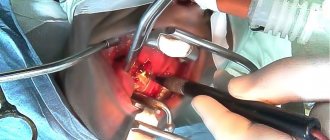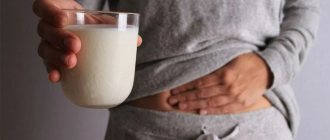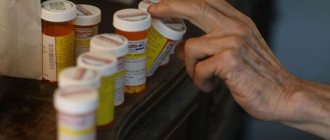Pharmacological properties of the drug Sotahexal
SotaHexal is a non-selective β-adrenergic receptor blocker that acts on β1- and β2-adrenergic receptors. It has a pronounced antiarrhythmic effect, the mechanism of which is to increase the duration of the action potential and the absolute refractory period in all parts of the conduction system of the heart (Class III antiarrhythmic drugs). Reduces heart rate and myocardial contractility, slows AV conduction, and reduces the absolute refractory period. By blocking β2-adrenergic receptors, it increases the tone of smooth muscles of the bronchi and blood vessels. After oral administration, 75–90% of sotalol hydrochloride is absorbed from the gastrointestinal tract. Due to the lack of effect of the first phase, absolute bioavailability is 75–90%. The time to reach maximum concentration in blood plasma is 2–3 hours. The volume of distribution is 1.6–2.4 l/kg. Sotalol does not bind to plasma proteins and is not metabolized in the body. Up to 90% of the dose taken is excreted unchanged by the kidneys, the rest is excreted in feces. Renal clearance is 120 ml/min and corresponds to the total clearance of the body. The half-life is 10–20 hours. If renal function is impaired, the elimination of sotalol may increase to 42 hours, which requires a reduction in the dose of the drug.
Indications for use of the drug Sotahexal
Supraventricular tachyarrhythmias accompanied by clinical symptoms (including atrioventricular, nodal, paroxysmal tachycardias in WPW syndrome or paroxysmal atrial fibrillation arrhythmias); maintaining normal sinus rhythm after stopping atrial fibrillation or flutter; severe ventricular heart rhythm disturbances, which are accompanied by severe clinical symptoms (tachyarrhythmias) and their prevention with proven effectiveness; arrhythmias caused by excess circulation of catecholamines or increased sensitivity to catecholamines.
Characteristics of the drug
Sotahexal reduces the force of heart contractions, reduces their frequency, and strengthens the heart muscles. The active ingredient of the drug is sotalol hydrochloride. Dosage form – tablets and ampoules with injection solution. The drug is available only with a doctor's prescription.
Sotahexal is a drug with antianginal, antiarrhythmic and hypotensive effects.
The manufacturer's instructions stipulate the rules of administration, permissible doses, contraindications, and possible side effects. The medicine requires strict adherence to medical recommendations. Self-medication with Sotahexal is dangerous to the patient's health. The manufacturer's instructions state the negative compatibility of Sotahexal and alcohol.
Indications and restrictions for taking Sotahexal
The drug is used to treat only cardiac diseases and is prescribed for:
- chronic heart rhythm pathologies;
- tachycardias of various forms;
- ventricular extrasystole and other cardiac problems.
There are restrictions on taking the drug. Additional monitoring of blood pressure and heart rate is necessary if the patient:
- has diabetes;
- has kidney pathology;
- follows a strict diet;
- suffers from psoriasis;
- is in old age.
Use of the drug Sotahexal
Dose adjustment of SotaHexal in cases of ventricular arrhythmia should be carried out under the constant supervision of a cardiologist; it can be carried out with appropriate equipment in the cardiac emergency room and continuous monitoring. During treatment, screening tests should be carried out at regular intervals (for example, standard or long-term ECG). If individual ECG parameters are changed, therapy must be carefully analyzed, for example, in cases of QRS QT interval by more than 25% , a 50% increase in PQ QT by more than 500 ms , an increase in the number of attacks or severity of arrhythmia. Treatment of tachyarrhythmias The recommended starting dose of SotaHexal is 40 mg 2 times a day. Subsequently, the drug is prescribed in a daily dose of 160–320 mg, divided into 3 doses. If necessary, the dose of the drug can be increased to 160 mg 3 times a day. Severe ventricular heart rhythm disturbances with severe tachyarrhythmia The initial dose of SotaHexal is 80 mg 2 times a day. If necessary, the daily dose can be increased to 80 mg 3 times a day or up to 160 mg 2 times a day. In case of insufficient effectiveness in the treatment of arrhythmia that threatens the patient's life, the daily dose of SotaHexal can be increased to 480 mg, divided into 2 doses. In these cases, the dose should be increased only if the potential benefit outweighs the potential risk of severe adverse reactions (especially proarrhythmic effects). Atrial fibrillation The initial dose of SotaHexal is 80 mg 2 times a day. If necessary, the daily dose can be increased to 80 mg 3 times a day. In cases of paroxysmal atrial fibrillation, this dose should not be exceeded. If in patients with chronic atrial fibrillation the effectiveness of treatment is insufficient, the dose of sotalol hydrochloride can be increased to a maximum of 160 mg 2 times a day. The dose can only be increased at minimum two to three day intervals. Recommended doses for renal failure In severe renal failure, the use of sotalol hydrochloride is recommended only with regular monitoring of the ECG and the concentration of the drug in the blood serum. If creatinine clearance decreases to 10–30 mol/min (serum creatinine 2–5 mg/dL), a dose reduction of 50% is recommended. If the value of this indicator is less than 190 ml/min (serum creatinine ≤5 mg/dl), then a dose reduction by 1/4 is recommended. SotaHexal tablets should be swallowed without chewing, with a sufficient amount of liquid (for example, a glass of water) before meals. When adjusting the dose in patients after myocardial infarction or with severe cardiac pathology, particularly careful monitoring (for example, using monitoring) should be established. During treatment, appropriate testing should be carried out at regular intervals. In patients with coronary artery disease and/or arrhythmia, as well as after prolonged use of the drug, treatment should be discontinued gradually, since abrupt withdrawal may lead to a worsening of the clinical picture of the disease. The duration of treatment is determined depending on the clinical course of the disease and the patient’s condition.
Combination with alcohol
The instructions for the drug, which are contained in each package of the drug, contain information that simultaneous use with alcohol should be avoided. This is due to a number of side effects that can develop when combining substances. As a rule, adverse reactions do not develop immediately and not from the first use, but everything is purely individual and requires detailed consultation with a specialist.
In particular, the first thing you should pay attention to when taking alcohol with medication at the same time is the lack of the necessary therapeutic effect, which is declared by the manufacturers of the pharmaceutical product. Alcohol products can negate all the results of long-term treatment and cause irreparable harm to human health.
The second argument against combination should be the development of dangerous conditions. For example, if you drink alcohol and take Sotahexal tablets at the same time, your blood pressure may drop sharply. This is fraught with pathological changes in the functioning of the heart. In some cases, such consequences are irreversible.
Thus, when prescribing therapy with Sotahexal, the patient must completely stop drinking alcohol for the duration of treatment. Otherwise, the consequences can be very dire. The minimum that awaits a person is the absence of a therapeutic effect without causing significant harm to the body. Every person should understand the seriousness of the treatment being carried out and the harmful consequences that are possible after taking the drug simultaneously with alcohol.
Contraindications to the use of the drug Sotahexal
Chronic heart failure stage IIB–III; acute myocardial infarction; shock; arterial hypotension; AV block II and III degrees; sinoatrial block; sick sinus syndrome; bradycardia (heart rate less than 50 beats/min); prolongation of the QT ; obliterating vascular diseases; obstructive airway diseases; metabolic acidosis; swelling of the larynx; severe allergic rhinitis; untreated pheochromocytoma; hypokalemia and hypomagnesemia; hypersensitivity to the drug and sulfonamides; a rare hereditary form of galactose intolerance, lactase deficiency or glucose-galactose malabsorption. For patients treated with sotalol (except for intensive drug treatment), intravenous administration of calcium antagonists such as verapamil or diltiazem or other antiarrhythmic drugs (such as disopyramide) is contraindicated.
Side effects of the drug Sotahexal
cardiovascular system: chest pain, undesirable decrease in blood pressure, increased symptoms of heart failure, bradycardia, tachycardia, ECG changes, impaired atrioventricular conduction, syncope or presyncope, edema; very rarely - increased frequency of angina attacks and impaired peripheral perfusion; proarrhythmic effects are possible - in the form of changes or intensification of arrhythmia (can lead to significant impairment of cardiac activity); arrhythmogenic effects (especially often noted in patients with life-threatening arrhythmia and impaired left ventricular function); ventricular tachyarrhythmia (sotalol hydrochloride prolongs the QT ); Gastrointestinal tract: taste disturbance, abdominal pain, nausea, vomiting, diarrhea, dyspepsia, xerostomia. Metabolic disorders: hypoglycemia; increase in total cholesterol and triglycerides, decrease in cholesterol in the HDL fraction. Nervous system: anxiety, confusion, sudden changes in mood, hallucinations, frequent dreams, depression, vertigo, headache, sleep disturbance, fever, feeling tired, paresthesia and cold sensations in the extremities. Hypersensitivity reactions: erythema, itching, exanthema; very rarely - alopecia, psoriasis-like exanthema or increased severity of psoriasis symptoms; anaphylactic reactions. Respiratory system: dyspnea; rarely - allergic bronchitis with fibrosis, temporary hearing loss. Visual organs: dysopia; rarely - conjunctivitis, keratoconjunctivitis, decreased severity of tear secretion. Musculoskeletal system: muscle spasm or myasthenia gravis.
Possible consequences
When antibiotic molecules and ethanol come into contact, the body receives severe intoxication. This can be expressed by various symptoms. Most often they appear:
- nausea and vomiting;
- attacks of severe headache;
- cardiopalmus;
- heat;
- redness of the skin of the face and neck;
- leg and arm cramps;
- heavy and intermittent breathing.
Any of the detected symptoms should cause you to contact a doctor. In this case, the use of both alcohol and medicine must be stopped immediately. Further combination of substances will lead to even more serious consequences.
Special instructions for the use of the drug Sotahexal
Treatment with sotalol is carried out under the control of heart rate, blood pressure, and ECG. Constant medical monitoring of patients is necessary in the following cases:
- in case of renal failure (it is necessary to monitor the concentrations of creatinine and sotalol hydrochloride in the blood serum at certain intervals);
- in diabetes mellitus with significant fluctuations in blood glucose levels, while the symptoms of hypoglycemia can be masked (it is necessary to monitor the concentration of glucose in the blood);
- while following strict diets;
- with hyperthyroidism (in this case, adrenergic symptoms can be masked);
- in case of peripheral perfusion disorders;
- for pheochromocytoma (the drug can be used only after blockade of α-adrenergic receptors).
During the period of use of sotalol, patients who have suffered a myocardial infarction or patients with impaired myocardial contractility should be under the supervision of a cardiologist. When discontinuing the drug, the dose is reduced gradually; Particular care is taken when stopping treatment in patients with coronary artery disease and cardiac arrhythmias, as well as after prolonged use of the drug. The question of discontinuing or changing the dosage regimen of the drug in patients with life-threatening cardiac arrhythmias can only be decided by a doctor. Sotalol may increase sensitivity to allergens and increase the severity of anaphylactic reactions, which must be taken into account when treating patients with a history of severe hypersensitivity reactions and those on desensitization therapy. Severe proarrhythmia (sustained ventricular tachycardia, ventricular flutter/fibrillation), predominantly dose-dependent, is noted mainly at the beginning of therapy, as well as with increasing doses of the drug. In cases of severe diarrhea or concomitant use of drugs that cause loss of magnesium and/or potassium, it is necessary to monitor the electrolyte balance and acid-base balance. Since sotalol hydrochloride is found in urine, photometric determination of metanephrine may result in overestimated values. In patients who have taken sotalol, as well as with suspected pheochromocytoma, determination of metanephrine in urine should be carried out using the HPLC method with solid phase extraction. When treating elderly patients, it is necessary to take into account possible renal failure and make appropriate dose adjustments. Pregnancy and breastfeeding Since there is no experience with the use of sotalol during pregnancy, the drug can be prescribed during this period only with an accurate diagnosis and absolute indications for its use. It must be taken into account that sotalol hydrochloride crosses the placenta and reaches pharmacologically active concentrations in fetal tissues, as a result of which the fetus or infant may develop undesirable effects such as bradycardia, hypotension and hypoglycemia. For this reason, therapy should be interrupted 48–72 hours before the expected date of delivery. After birth, the child must be closely monitored for some time (beta receptor blockade may develop). Breastfeeding should be stopped during treatment with the drug. Effect on the ability to drive vehicles and other mechanisms The drug can change the body's reaction rate, which affects the ability to drive vehicles and other mechanisms, especially at the beginning of treatment.
Possibility of drinking alcohol
There are average indicators for when men and women can drink alcohol for the first time after undergoing a course of treatment or taking a single pill. Experts also indicate the time frame for withdrawing alcohol, after which you can take the first pill without fear.
If the drug needs to be taken once, then this can be done 20 hours after drinking alcohol for men and 24 hours for women. Before drinking alcohol, you also need to monitor the course of taking pills. It is recommended to take the last tablet 24 hours before for men and 48 hours before for women.
After completing a course of treatment with Sotahexal tablets or ointment, you can drink alcoholic beverages no earlier than a month later. These periods are averaged and must be calculated strictly individually, according to the research conducted by the doctor and his recommendations.
Doctors advise not only to abstain from drinking alcohol during treatment, but also to abstain from alcohol in the post-therapy period. Only in this case the effect of therapy will be complete and the patient will feel relief.
Drug interactions Sotahexal
Concomitant use with calcium antagonists (verapamil or diltiazem), other antiarrhythmic drugs (disopyramide), as well as beta-adrenergic receptor blockers, calcium ion antagonists (such as nifedipine) can lead to a significant decrease in blood pressure and heart rate. The intravenous administration of calcium ion antagonists such as verapamil or diltiazem, as well as other antiarrhythmic drugs (disopyramide), is contraindicated, with the exception of intensive care. Combination therapy with class I antiarrhythmic drugs (especially quinidine-like drugs) or other class III antiarrhythmic drugs can cause intense prolongation of the Q-T on the ECG and at the same time increase the risk of ventricular arrhythmia. Concomitant use with drugs that cause intense prolongation of QT on the ECG (tricyclic and tetracyclic antidepressants (imipramine, maprotiline), antihistamines (astemizole, terfenadine), quinolone antibiotics (for example, sparfloxacin), macrolide antibiotics (erythromycin), probucol, haloperidol and gelofantrine), leads to an increased risk of proarrhythmic effects (“flutter-flickering”). When used simultaneously with norepinephrine or MAO inhibitors, as well as after discontinuation of clonidine, blood pressure may increase sharply. When using SotaHexal simultaneously with β2-adrenergic receptor agonists, such as salbutamol, terbutaline and isoprenaline, it may be necessary to increase the dose of the latter. Concomitant use with tricyclic antidepressants, barbiturates, phenothiazines, narcotics, as well as antihypertensive drugs, diuretics and vasodilators can lead to a sharp decrease in blood pressure. The negative chronotropic and dromotropic effects of sotalol may be enhanced by concomitant administration of reserpine, clonidine, alpha-methyldopa, ganfacine and cardiac glycosides. The neuromuscular blockade caused by tubocurarine can be increased by β-adrenergic receptor blockade. Concomitant use with insulin or oral antibiotics, especially during strenuous exercise, may induce hypoglycemia and mask its symptoms. The risk of arrhythmia increases with the simultaneous administration of potassium-sparing diuretics (furosemide, hydrochlorothiazide) or other drugs, the use of which causes a loss of potassium or magnesium.
Possibility of combined use of alcohol with the drug Sotahexal
Patients suffering from various forms of tachycardia are often treated with Sotahexal, and alcohol is completely prohibited. This is explained by the fact that when combining substances, the opposite effect may develop and the heart rate will increase even more. This is a dangerous condition for the body that can have disastrous consequences. In addition, the drug has a large number of contraindications. In relation to the pathological condition and alcohol, the medication may give a negative result.
Overdose of the drug Sotahexal, symptoms and treatment
symptoms: loss of consciousness, dilated pupils, convulsions, severe bradycardia up to asystole, severe arterial hypotension, bronchospasm, decompensated heart failure, as well as atypical ventricular tachycardia (flutter - fibrillation) and symptoms of cardiovascular shock. Treatment: symptomatic. In addition to the general determination of the primary elimination of a substance, in conditions of intensive treatment it is necessary to monitor vital parameters and, if necessary, make appropriate adjustments. Atropine 1–2 mg is administered intravenously as an infusion (bolus); beta-sympathomimetics depending on body weight and effect: dopamine, dobutamine, isoprenaline, orciprenaline and epinephrine; The use of glucagon is effective: initially 1–10 mg IV, then 2.0–2.5 mg/hour as a continuous infusion. Refractory bradycardia should be treated with a temporary pacemaker.
Side effects
From the nervous system and sensory organs: dizziness, headache, feeling of fatigue, sleep disturbance, confusion, paresthesia, depression. Inflammation of the cornea and conjunctiva (should be taken into account when wearing contact lenses), blurred vision (extremely rare), decreased tear production.
From the cardiovascular system and blood (hematopoiesis, hemostasis): heart failure, bradycardia, AV block, angina pectoris (in rare cases), hypotension.
From the respiratory system: bronchospasm.
From the gastrointestinal tract: nausea, diarrhea, constipation, dry mouth.
Metabolism: hypoglycemia (more often in patients with diabetes mellitus or with strict adherence to a diet).
From the genitourinary system: decreased potency.
From the musculoskeletal system: a feeling of coldness in the extremities, muscle weakness or cramps.
From the skin: skin rash, itching (rare); redness, psoriasiform dermatosis, alopecia.








